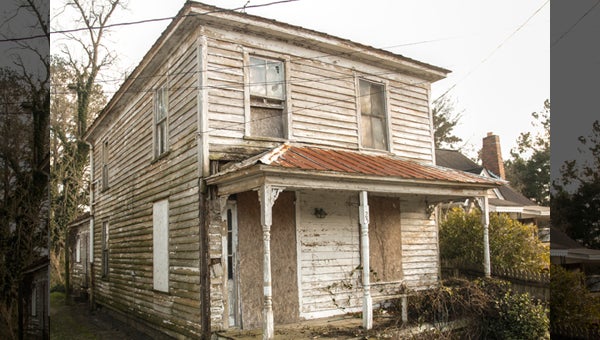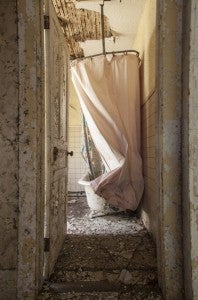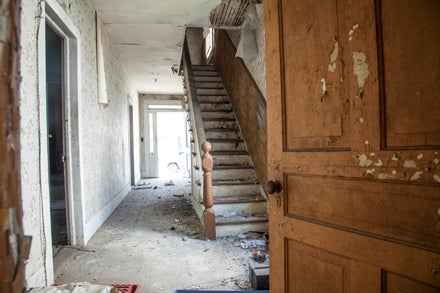PAST TO FUTURE: Demolition by neglect a tool for preservation
Published 7:44 pm Thursday, March 31, 2016

EMILY REBERT
WORTH SAVING: A recent trip to a Harvey Street home by historic preservationists revealed the property is worth saving. Aesthetically, the boarded-up circa 1910 home is a mess, but it’s structurally sound with an intact roof. It’s one of approximately 50 homes that have been, or will be, contacted about the City of Washington’s demolition by neglect ordinance.
Owning an old house is not for everyone, must less owning a home within a historic district. Often that ownership comes with a different set of priorities, some of which are defined by those charged with preserving a town’s structural history for future generations.
That’s the role of Emily Rebert, Washington’s community development planner. This year, Rebert has embarked on a campaign to protect the town’s historic structures — commercial and residential — that are falling into disrepair by way of the city’s demolition by neglect ordinance.
While the words “demolition by neglect” may evoke images of bulldozers and razed homes for some, enforcement of the ordinance is far removed from those images.
“Everyone thinks that when you hear ‘demolition by neglect’ ordinance that they’re coming to tear your house down. It’s actually the exact opposite. What it’s doing is giving us a tool to use to prevent that,” Rebert said.
It started with a list of properties in the historic district, ones that had issues, whether those issues are confined to a house in need of an exterior coat of paint or more extensive, such as a vacant home, boarded up and deteriorating through time and the elements. Of the approximately 600 structures in the historic district, about 50 of them fall into the category, Rebert said. Letters continue to be sent, letting those property owners know the repairs need to be made. Currently, Rebert is working with 12 properties and their owners to make it happen.
“Sadly, it takes the demolition by neglect ordinance to get people to work on their property,” Rebert said. “I’m pretty happy with it so far. Everyone’s been great to work with on this whole thing.”
Recently, Rebert, North Carolina State Historic Preservation Office restoration specialist John Wood and Preservation NC regional director Claudia Deviney took a tour of some of the properties that fall under Washington’s demolition by neglect ordinance.
One of the stops was a boarded-up home on Harvey Street that sits in the middle of a block of early 20th-century rowhouses in varying states of repair. In the eyes of the historic preservationists, the entire block of homes is a prime candidate to become a shining example for restoration.
“To see all those houses on that street fixed up and have them painted. That would be really cute, really precious,” Rebert said.
Not everyone has the time, the ability, the desire and especially the funds to repair a historic home, however. But Rebert is realistic about the process.
“These houses did not fall apart in one year. I recognize it. I recognize that these houses aren’t going to be fixed in one year. I just need a plan,” Rebert said. “I’m asking them to give a timeline. It’s an accountability tool that we can use to get people preserving their houses.”
Rebert asks owners to start with a small project, such as cutting back overgrown shrubs and vines. She also enters conversations with property owners armed with their options.
For those with the means to repair, she reminds them of the hefty tax credits that can help with the cost.
“Everyone’s interested in using the tax credits to fix up their houses, so that’s a real blessing that they brought that back,” Rebert said. “Between state and federal tax credits, you’re getting 40 percent back.”
Preservation NC, a private nonprofit that’s been working to preserve North Carolina’s historic properties since 1939, may offer several options to homeowners, depending on the state of the property.
In the case of the Harvey Street house, the property was passed down from generation to generation. While the current owners would like to see it restored, they don’t have the means restore it. Enter Preservation NC: the homeowner could donate the property to the organization for a tax write off. PNC may also help owners hoping to sell a historic property a courtesy real estate listing on its website or take a more active roll in marketing a historic home for a small fee. If the property is in good shape, PNC may buy it outright from a property owner.
For others, selling or donating their home isn’t an option, but another option exists in presenting a case of economic hardship to the Historic Preservation Commission — economic hardship that prevents a homeowner from making repairs.
“There are a couple of properties that I know right off the bat would be able to declare economic hardship, and, right now, I’m not approaching them,” Rebert said. “Everyone’s stuck between and rock and a hard place on that one.”
Ultimately, Rebert envisions a city-overseen revolving fund that would assist homeowners who can’t afford to make cosmetic repairs, as well as a slew of volunteers who would donate time and energy to spruce up a historic property, and preserve that property for generations to come.
For Rebert and all other preservationists, the past is not just about the present, but the future.
“It’s honoring our past and preserving it for our future generations, and when people are letting that fall apart, it’s bringing everyone else down,” Rebert said. “It’s not fair for the city to just stand by and let it happen. We’ve got to do something. We’re trying to get things moving in a positive direction.”








